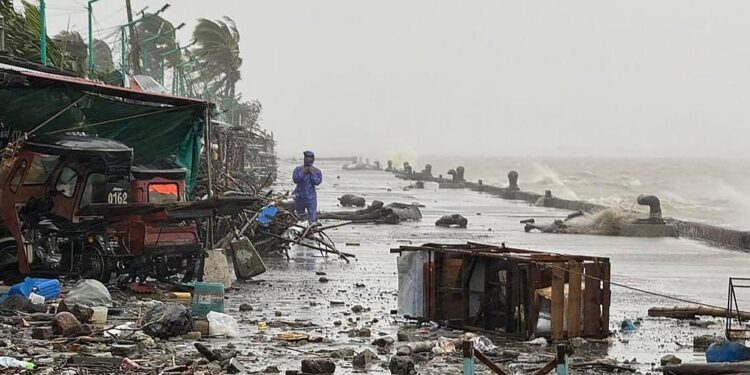Typhoon Ragasa, one of the most powerful storms in recent years, killed at least 27 people across Taiwan and the Philippines before making landfall in southern China Wednesday with devastating winds reaching 150 mph.
The storm claimed 17 lives in Taiwan’s Hualien County after heavy rainfall caused a barrier lake to overflow Tuesday, creating torrents that destroyed bridges and turned roads in Guangfu township into churning rivers that swept away vehicles and furniture.
In the northern Philippines, at least 10 people died, including seven fishermen whose boat capsized Monday off Santa Ana town in Cagayan province after being battered by massive waves and fierce winds. Five additional fishermen remain missing, according to provincial officials.
Nearly 700,000 people in the Philippines were affected by the typhoon, with 25,000 seeking shelter in government emergency centers.
Ragasa made landfall along China’s Hailing Island coast in Yangjiang city at approximately 5 p.m. with maximum sustained winds of 144 kph (89 mph), according to state broadcaster CCTV. Nearly 1.9 million people were evacuated across Guangdong province as the storm approached.
A weather station in Chuandao town recorded maximum wind gusts of 241 kph, the highest on record for Jiangmen city since data collection began. Chinese officials allocated 150 million yuan ($21 million) for relief efforts across affected provinces.
Hong Kong experienced severe impacts as the typhoon passed approximately 100 kilometers south of the city. Strong winds destroyed parts of a pedestrian bridge roof, toppled hundreds of trees, and sent waves crashing through hotel doors in viral social media footage.
The territory’s observatory classified Ragasa as having maximum sustained winds of 195 kph, making it the strongest tropical cyclone in the northwestern Pacific and South China Sea this year. The storm ranks as the second-strongest in the South China Sea since record-keeping began in 1950.
Hong Kong hospitals treated 90 people for storm-related injuries as seawater flooded promenades, cycling lanes, and playgrounds. A vessel crashed into the waterfront, shattering glass railings, while restaurant furniture was scattered by powerful winds.
Macao also suffered significant flooding, with streets transformed into debris-filled streams requiring rescue crews to deploy inflatable boats. The gambling hub’s electricity supplier suspended power in low-lying areas for safety reasons.
In Taiwan’s Guangfu township, home to 8,450 residents, more than half sought refuge on higher floors or elevated ground. Rescue teams established contact with over 100 previously unreachable residents and conducted door-to-door welfare checks.
The typhoon forced widespread transportation shutdowns across the region. Schools, factories, and transport services were suspended in approximately a dozen Chinese cities, though some distant from the landfall location began preparing to resume operations as winds weakened.
Train services in China’s Guangxi region face Thursday suspensions as the storm continues moving westward. Both Hong Kong and Macao canceled flights and closed schools, with hundreds seeking shelter in temporary evacuation centers.
The storm’s intensity and widespread impact demonstrate the increasing power of Pacific typhoons, with meteorologists noting Ragasa’s exceptional strength and destructive capability across multiple countries and territories.
Recovery efforts are underway across all affected regions, with international attention focused on the extensive infrastructure damage and humanitarian needs in rural communities hit hardest by flooding and wind damage.







